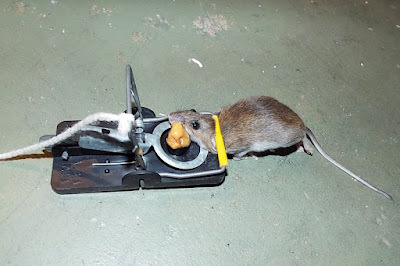Types of Rat Snap Traps and Their Effectiveness
Rats can be a nuisance and even a health hazard if they are allowed to invade our homes or businesses.
There are various ways to get rid of rats, but one of the most effective methods is to use rat snap traps.
However, not all rat snap traps are created equal, and choosing the right type of trap is crucial to achieving success in trapping rats.
In this blog post, we'll explore the different types of rat snap traps available, their pros and cons, and how effective they are at trapping rats.
We'll also offer practical tips on how to choose the right type of trap and use it effectively to get rid of rats in your home or business.
Types of Rat Snap Traps
1. Traditional Wooden Snap Trap
The traditional wooden snap trap, also known as the Victor snap trap, is the most common and widely recognized type of rat trap. It consists of a wooden base with a metal wire snap that closes when the bait is triggered, killing the rat instantly.
Pros:
- Easy to set up and use
- Inexpensive
- Can be used multiple times
Cons:
- Can be difficult to dispose of dead rats
- Can be dangerous for pets and children if not placed in a secure location
- Not effective for larger rats
2. Plastic Snap Trap
The plastic snap trap is a more modern version of the traditional wooden snap trap. It is made of durable plastic and features a powerful snap mechanism that kills the rat instantly.
Pros:
- Easy to set up and use
- Can be reused multiple times
- Less dangerous for pets and children than traditional wooden snap traps
- Disposable and hygienic
Cons:
- More expensive than traditional wooden snap traps
- May not be as effective for larger rats
3. Electronic Snap Trap
The electronic snap trap is a high-tech alternative to the traditional snap trap. It uses a powerful electric shock to kill the rat instantly and can be used with or without bait.
Pros:
- Highly effective
- Safe for pets and children
- Can be used with or without bait
- Easy to dispose of dead rats
Cons:
- More expensive than traditional snap traps
- Requires batteries or a power source
4. Glue Trap
The glue trap is another type of rat trap that uses a sticky adhesive to trap the rat. The rat is attracted to the bait and then becomes stuck to the trap, making it unable to move.
Pros:
- Easy to set up and use
- Inexpensive
- Disposable and hygienic
Cons:
- Can be cruel and inhumane, as the rat may take hours or even days to die
- Not effective for larger rats
- Difficult to dispose of live or dead rats
Effectiveness of Different Types of Rat Snap Traps
The effectiveness of different types of rat snap traps depends on various factors, such as the size of the rat, the type of bait used, and the placement of the trap. Generally, snap traps are more effective than glue traps, as they kill the rat instantly and require less monitoring.
However, the traditional wooden snap trap may not be as effective for larger rats, while the plastic snap trap may not be as durable as the traditional wooden snap trap.
The electronic snap trap is highly effective but can be expensive, while the glue trap is inexpensive but may be inhumane.
Here are some tips for using rat snap traps effectively:
- Choose the right type of trap for the size of the rat and the location of the infestation.
- Place the trap in areas where rats are known to frequent, such as along walls, near food sources, or in dark corners.
- Use a high-quality bait that is attractive to rats, such as peanut butter or cheese.
- Place multiple traps in different locations to increase your chances of trapping rats.
- Check the traps frequently and dispose of dead rats promptly to avoid attracting other pests or creating unpleasant odors.
Final Words
Rat snap traps are an effective way to get rid of rats in your home or business. There are several types of rat snap traps available, including the traditional wooden snap trap, plastic snap trap, electronic snap trap, and glue trap.
Each type of trap has its pros and cons, and the effectiveness of the trap depends on various factors.
When choosing a rat snap trap, consider the size of the rat, the type of bait used, and the location of the infestation.
Remember to place the trap in areas where rats are known to frequent, use a high-quality bait, and dispose of dead rats promptly to avoid creating unpleasant odors.
We hope that this blog post has been helpful in providing you with a comprehensive overview of the different types of rat snap traps available and their effectiveness.
By choosing the right type of trap and using it effectively, you can get rid of rats and create a safer and more hygienic environment for yourself and your family or customers.



0 comments:
Post a Comment